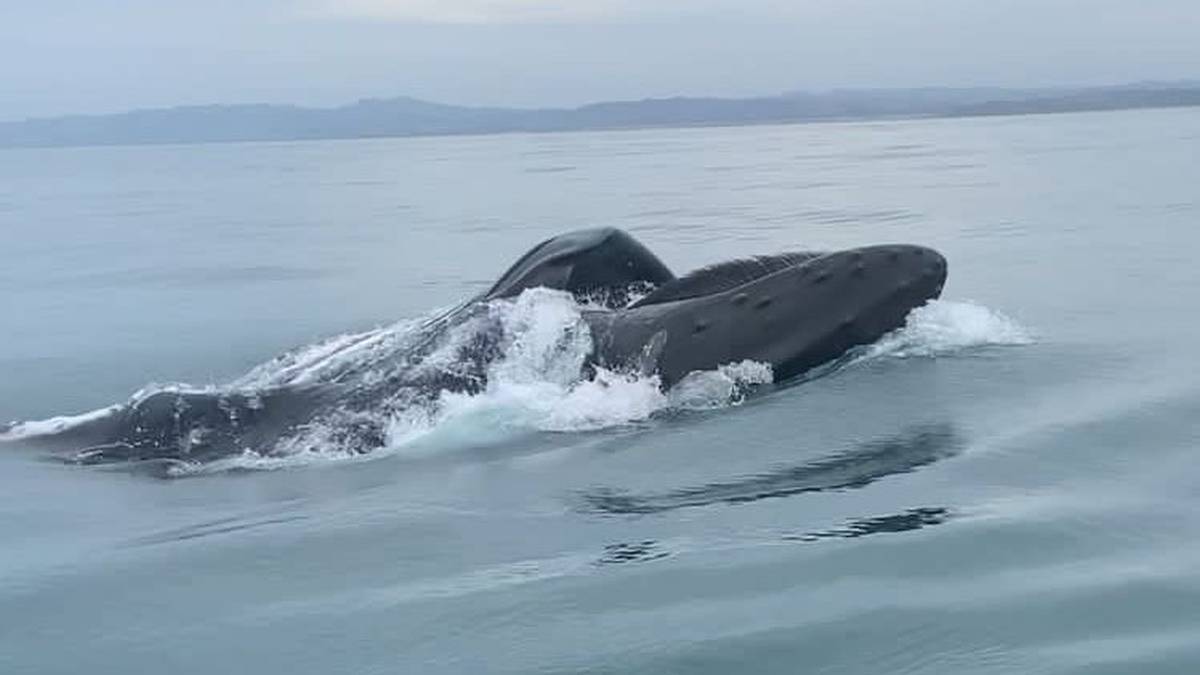Video shows the incredible moment a humpback whale was spotted off the coast of Mangawhai Heads. Video / Jude Salisbury
Humpback whales have returned to the waters off Mangawhai Heads for the first time in a long time and onlookers watched one on a swimming and feeding frenzy.
The humpback whale was spotted off Mangawhai Heads on Sunday and a whale expert said it was “fantastic news” since the mammals haven’t used the area to migrate for a long time.
Auckland business owner Jude Salisbury was out with friends boating and fishing when the group spotted something big in the water. They couldn’t say whether it was a shark or whale at first.
The group turned off the motor 35m offshore and Salisbury said she was excited – as well as a bit scared – to see the marine mammal up close.
“We were a bit scared but it seemed to keep distant.”
Salisbury had a failed attempt at whale watching during a Tonga trip seven years ago and said luckily she was able to spot the mammal so close to home.
/cloudfront-ap-southeast-2.images.arcpublishing.com/nzme/LFVFGXERU6LZN252OM5LKATCWM.jpg)
Whale expert Ingrid Visser confirmed it was a humpback whale and said the species generally headed north towards the tropics where they socialise, mate, and give birth during this time of the year.
However, for Visser, the whale feeding in the water was a particularly fascinating feature of the encounter.
In the video, the whale can be seen rising up and lunging while swimming on its sides. The throat pleats open up as it swallows a mouth full of water and fish.
Nearby fish are spooked to the surface at one point and can be heard scattering.
Visser said she wasn’t aware of humpback whales being documented feeding in the Bream Bay area before and it was a real bonus for Northlanders to know they were using the area in this way.
“Typically, humpback whales, as they migrate north, don’t feed, however, if they stay in one area for a few days, which does happen along our Northland coastline, they will often grab a ‘snack’ on the run.
“Humpback whales used to use the Bream Bay area extensively in the early days (before whaling nearly wiped them out).
“They are starting to make a recovery, which is a credit to all those who advocated for their protection and who continue to strive to keep our ocean healthy.”
/cloudfront-ap-southeast-2.images.arcpublishing.com/nzme/47J7J2HPF3KEN46E56K3GCN2KY.jpg)
Photo / Supplied Bryce Leckie
While the whale in the video was not seen making any dramatic ‘tails up high as they dive’ move, Visser said the species was well renowned for their high and spectacular breaches.
“But, yes, ‘mood’ can play a role in what we see from the surface, and in this case, the whale was focused on feeding.
“As the fish were close to the surface – as evident by them jumping out of the water – the whale didn’t need to dive deep so no need to raise its tail high either.”
The expert had encountered many humpback whales in the Whangarei/Bream Bay area and the one inside the harbour was the first-ever documented case of the species in that area.
“There have also been humpback whales in the Bream Bay area that have been entangled in fishing gear.”
Visser encouraged people to call the hotline about entangled whales at 0800 7283 94253 (0800 SAVE WHALE).
Meanwhile, Thursday is World Orca Day.
Ingrid Visser founded World Orca Day in 2013 to celebrate the species and it had since been gaining momentum.
/cloudfront-ap-southeast-2.images.arcpublishing.com/nzme/T6SQ5LIZAOUNNLT4O35K63NV7E.jpg)
Visser would give a live webinar hosted by the Whale Sanctuary Project in Canada on Friday and said people from all over the world were part of it.
Anyone interested can register at https://whalesanctuaryproject.org/event/a-special-event-for-world-orca-day/




